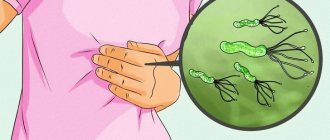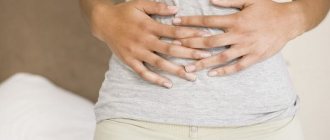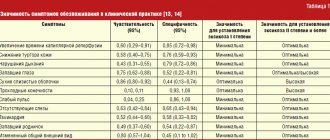The postpartum period is the period of time during which the female body returns to normal after childbirth. It begins immediately after the birth of the child and ends after 6-8 weeks. Usually this period proceeds normally, but sometimes complications arise that require medical attention.
At MedicCity, qualified obstetricians-gynecologists, gynecologists-endocrinologists and gynecologists-mammologists, who are distinguished by their professionalism and delicacy, receive daily consultations. The latest Voluson 10 ultrasound scanner allows you to identify problems in the female body at the earliest stages. We know how to solve any problems that a patient may encounter during the postpartum period!
1 Observation in the postpartum period
2 Observation in the postpartum period
3 Observation in the postpartum period
What changes occur in the postpartum period?
Immediately after giving birth, a woman's uterus begins to contract. The walls of the uterus become denser, and the vessels of the placental site (i.e., the place where the placenta is attached) are compressed. Subsequently, the uterus continues to contract and acquires its original size.
During the postpartum period, regeneration of the uterine mucosa occurs, accompanied by discharge (lochia). Depending on the duration of the postpartum period, lochia has a different color and character - from bloody at the beginning to serous at the end.
The cervix is finally formed 2-3 weeks after birth.
The vagina contracts and shortens over three weeks. The perineum is restored in 10-12 days.
Features of the lactation period
Due to changes in hormone levels in the postpartum period, a woman experiences lactation. As a rule, the mother begins to produce milk 3-4 days after birth.
Women's breasts increase in volume, become hard and painful. Body temperature may increase. With proper feeding regimen, these unpleasant features gradually disappear.
In the first three days, colostrum is released from the woman’s mammary glands. Unlike milk, it contains a large amount of immunoglobulins and protein. There is not much colostrum, but it is 10 times more nutritious than milk, so even a small amount is enough to feed the baby. Then milk appears in the breast. But in order to always have enough of it, you need to adhere to a simple rule - regularly put the baby to the breast and do not overfeed the baby.
1 Consultation with a gynecologist in MedicCity
2 Consultation with a gynecologist in MedicCity
3 Ultrasound in MedicCity
Observation in the postpartum period
After childbirth is completed, the condition of the cervix, vagina and perineum is assessed for each woman in labor. If tears are found, they are immediately stitched up.
In the first few days, the mother is in the maternity hospital under the supervision of doctors. This is extremely necessary, since the vast majority of complications of the postpartum period, such as bleeding associated with poor uterine contractility and incomplete passage of placental tissue, occur in the first days after birth.
In the maternity hospital, mother and baby are monitored daily by a doctor and midwife. They try to prevent the occurrence of purulent-inflammatory diseases in the newborn and the mother.
The general well-being of the woman in labor, the condition of the uterus, external genitalia, mammary glands, as well as the nature of the discharge must be assessed. Body temperature is checked twice a day, and blood pressure and pulse are measured daily.
If the postpartum period proceeds normally, the newborn is vaccinated with BCG, and the mother and baby are discharged home after 3-4 days. Further observation is carried out by a gynecologist at the antenatal clinic.
For some reason, some mothers think that after the birth of a baby, only the baby needs regular medical care. But this is a wrong opinion!
To avoid numerous health problems, mom also needs to be seen by a gynecologist!
Diagnostics
Gastroendoscopy will help clarify the situation with the developing disease.
After childbirth, a woman’s body is weakened and can be affected by any disease. For an accurate diagnosis, the doctor conducts the following studies:
- Anamnesis collection. It is necessary to identify the patient’s diet and sleep patterns, chronic and genetic diseases in the family.
- Blood test, gastric juice (if necessary).
- X-ray.
- Ultrasonography.
- Gastroendoscopy.
What problems may appear in the postpartum period?
Constipation and urinary retention
In the first days after childbirth, problems with urination may appear. This is especially true for labor that takes a long time or is carried out by caesarean section. In such cases, urine is released using a catheter.
If you are prone to constipation, physical exercise and simple morning exercises help restore bowel function. If there is no stool for 4 days, you can use a laxative suppository.
Quite often, after childbirth, a woman develops hemorrhoids, the treatment of which should be entrusted to a professional - a proctologist.
1 Consultation with a proctologist
2 Consultation with a proctologist
3 Consultation with a proctologist
Vaginal discharge
The appearance of blood discharge from the vagina in the first days after childbirth is a common occurrence. In the first 2-3 days the discharge is quite abundant, then it becomes less and it turns brown.
Cracked nipples
Cracked nipples are also quite common. To avoid cracks, in the first days, try not to breastfeed your baby for more than 7 minutes. Before each time you put your baby to the breast and after feeding, wash your breasts with warm water and soap and dry them with a towel. Be sure to wash your hands before feeding. You can use a special cream for cracked nipples.
Nagging pain in the lower abdomen
Contractions of the uterus are accompanied by painful sensations that are a bit like contractions. The pain may worsen while breastfeeding. Performing postpartum exercises helps strengthen the pelvic muscles and achieve rehabilitation faster.
Pain in the perineum occurs in women who have suffered ruptures in this area during childbirth. Healing occurs within 7-10 days. If the pain is severe, the doctor may prescribe painkillers to the patient.
The baby does not suck all the milk
If the baby does not suck all the milk, then it is necessary to express the remaining milk to avoid stagnation of fluid in the breast. Thanks to this simple technique, you can enhance lactation and prevent lactostasis.
The postpartum period is characterized by exacerbation of chronic diseases, metabolic disorders, endocrinological problems, and the menstrual cycle may also change.
The first days after childbirth
Pregnancy and Childbirth are a serious burden for the body of any mother. After childbirth, significant changes occur in the body, but it must be said that the restructuring cannot happen instantly. The woman will feel some changes immediately, but quite significant changes will occur over the course of several more weeks. What needs to change?
The first days after childbirth (postpartum ward)
In the first days after childbirth, there may be hemorrhages in the eyes - red eyes, on the face - numerous bluish dots, similar to moles, which appear during the second
period of childbirth. If a woman pushes incorrectly (holds her breath, screams, pushes “in the face”) or has peculiarities of the vascular wall, during pushing there is an increase in pressure in the vessels of the head, which can lead to rupture of blood vessels in and around the eyes . What to do with such red eyes?
Cold tea compresses on the eyes (10 minutes each), done several times a day, will have a calming effect and speed up recovery, which will occur in a maximum of 6-10 days. In about a week, the hemorrhages on the face will also disappear.
Cramping abdominal pain appears, intensifying during breastfeeding , which is associated with normal postpartum contractions of the uterus, which should contract and return to its pre-pregnancy size. Painful contractions of the uterus are more typical for repeated births and for the birth of twins. In primiparous women, there may be no such pain and uterine contractions are painless. Painful contractions may be more noticeable during breastfeeding, as sucking releases the hormone oxytocin, which stimulates uterine contractions.
After childbirth, in addition to reducing the size of the uterus, the mucous membrane of the uterus - the endometrium - must be restored. lochia appears from the genital tract - discharge of residual blood, mucus and tissue from the uterus. In the first three days after birth, they are usually bloody and as heavy (and sometimes more heavy) as during menstruation. Increased discharge when standing up and other movements is a normal process.
Muscle pain in different parts of the body can also bother a woman in the first days after childbirth. These pains are associated with the physical stress that a woman experiences during childbirth. These pains go away on their own within a few days.
Pain in the perineum and the discomfort associated with it - and this feeling is also normal, because it is unrealistic to expect that a 3-3.5 kg child will pass through the perineum without any consequences. Even if you avoided tearing during labor and did not have an episiotomy (an incision in the perineum), the area would still be stretched and compressed. The pain will go away in a few days.
In the case of an episiotomy, the pain may increase, especially when laughing, coughing, sneezing, or defecating. Like any wound, it does not heal immediately - it usually takes 5 to 7 days. At this time, the woman is forbidden to sit so that the stitches do not come apart. At the same time, they are allowed to sit on the toilet and perform regular sexual hygiene (after each visit to the toilet, you must wash the perineum with warm water, without soap, you should take a shower 2 times a day). While you are in the maternity hospital, your midwife and your doctor will examine your stitches for inflammation or other signs of infection. Sutures are usually removed on the 5th day.
In the first time after childbirth, only colostrum is released from the breast - a thick yellowish liquid, and milk appears on the 2-3rd day. By the 3rd day, the mammary glands often acquire increased sensitivity, sometimes bursting pain is felt in the chest , and a sensation of thickening of the mammary glands may appear. If there is significant breast engorgement, it is necessary to limit the amount of fluid consumed (but not less than 1 liter per day), increase the frequency and duration of feeding the baby. To prevent cracked nipples and when they appear, you will need the ointment BEPANTHEN, DEXPANTHENOL, SOLCOSERYL.
During the first days after birth, there may be difficulties with urination . Some women have no urge to urinate; others feel the need but cannot empty their bladder. Despite all the difficulties, it is necessary that the bladder is emptied in the first 6-8 hours after birth. This is done so that the enlarged bladder does not interfere with normal contractions of the uterus after childbirth. As a last resort, if it is not possible to empty the bladder within 4 hours after birth, the woman may be given a catheter. After childbirth, you need to urinate every 4 hours, regardless of desire. Bladder function returns to normal after 3-7 days.
The causes of bowel problems can be several factors, both physical and psychological. Establishing bowel function is rarely easy and quick; it will take several days.
Include more fiber in your daily diet: fermented milk products, beets, high-fiber fruits, dried fruits. This will soften the stool, but make sure that there are no allergens among the vegetables and fruits: remember that until milk comes in and lactation is established, you should not drink a lot of liquid. Try to move more if your condition allows. And don't worry about your stitches coming apart - they won't. Since before giving birth a woman often undergoes a cleansing enema, in the first 2-3 days, as a rule, there is no stool.
Immediately after childbirth, you cannot get out of bed on your own for 6 hours (only in the presence and with the help of a midwife), as you may feel dizzy .
After childbirth, the abdomen looks overstretched and somewhat saggy and does not immediately return to its original shape, since the muscles and skin need time to contract. In order to quickly return to your former shape, you can use breathing exercises (traditional gymnastics can only be performed 6-8 weeks after birth). Breathing exercises involve breathing with the stomach: as you inhale, inflate your stomach, while tightening the muscles of the perineum, and as you exhale, deflate it. Repeat 10-20 times, 4-5 times a day.
After a caesarean section: on the first day after the operation, you are only allowed to drink water up to 2-3 liters per day. But already on the second day, the mother is transferred to the postpartum ward, where she immediately begins to lead an active lifestyle - she gets up and walks, feeds her baby, unsweetened bread and broth without meat are allowed. From the third day, after a cleansing enema, it is allowed to take boiled food (porridge, boiled meat, sour-milk products, cottage cheese, tea without sugar), but butter cookies, buns, fresh fruits and vegetables are prohibited.
First week after birth
Vaginal discharge continues : Over the course of 1 to 2 weeks after delivery, the discharge gradually turns watery pink, then brown, and finally yellowish-white. During this period, you should use sanitary pads (not tampons: they can provoke inflammatory diseases of the uterus and appendages). The discharge may stop after two weeks, or may continue until the 6th-8th. If after the first week you notice the appearance of heavy bloody discharge, or discharge with an unpleasant odor, or an increase in temperature, you should consult a doctor. In this case, hospitalization and possibly uterine curettage may be necessary. You should also see a doctor if brownish or yellowish lochia continues to be discharged for more than 6 weeks, as it may be the result of an infection, especially if accompanied by fever or pain, or tenderness in the abdominal area.
The suture area after an episiotomy should be kept dry and clean. You can wash the external genitalia and perineum with a decoction of chamomile, calendula, and eucalyptus. For the first 2 months after birth, get out of bed carefully, first turning on your side, avoiding a sitting position (this will reduce pressure on the perineal muscles), and feed the baby lying on your side or half-sitting; You can't lift weights.
The birth of a child is a very significant event for a woman, not only physically, but also psychologically. Firstly, childbirth itself exhausts the mother, and secondly, the production of hormones changes during and after childbirth. Therefore, it is natural that at this time a period of mental instability .
The most typical feeling in the first days after childbirth is elation, but in the days and sometimes weeks that follow, some women become sad, depressed, withdrawn and apathetic. It is worth noting that these are common emotions for the postpartum period associated with the normalization of hormonal levels. In this situation, close people (spouse, parents) should come to your aid and help you cope with negative emotions.
For 7 days after a cesarean section (before removing the sutures), the nurse daily treats the postoperative suture with antiseptic solutions (for example, iodine, potassium permanganate) and changes the bandage. The skin scar forms approximately 5-7 days after surgery; Already a week after a caesarean section, you can shower completely calmly. Just don’t rub the seam with a washcloth - this can be done in another week. Discharged from the maternity hospital in the absence of any complications on the 5-7th day after surgical delivery. Since pain in the scar area can persist for up to several weeks, it may be difficult for a woman to bend over, so it is easier to sit down by bending her legs at the knee and hip joints.
Remember that recovery after childbirth usually takes about 6-8 weeks. However, the female body is individual. Therefore, each woman may experience the physical and emotional changes described above differently. Report any unusual or severe symptoms to your nurse or doctor.
Prepared by: Ass. department. obstetrics and gynecology Pavlyukova S.A. Head postpartum department Dvornik E.V.










